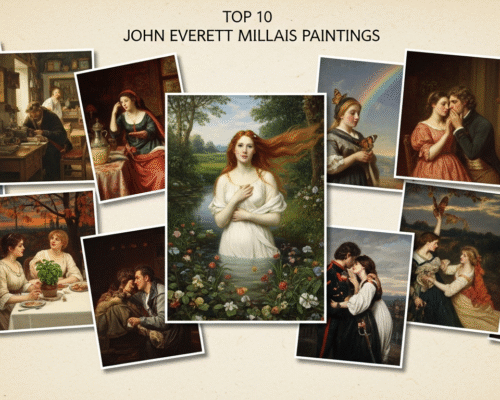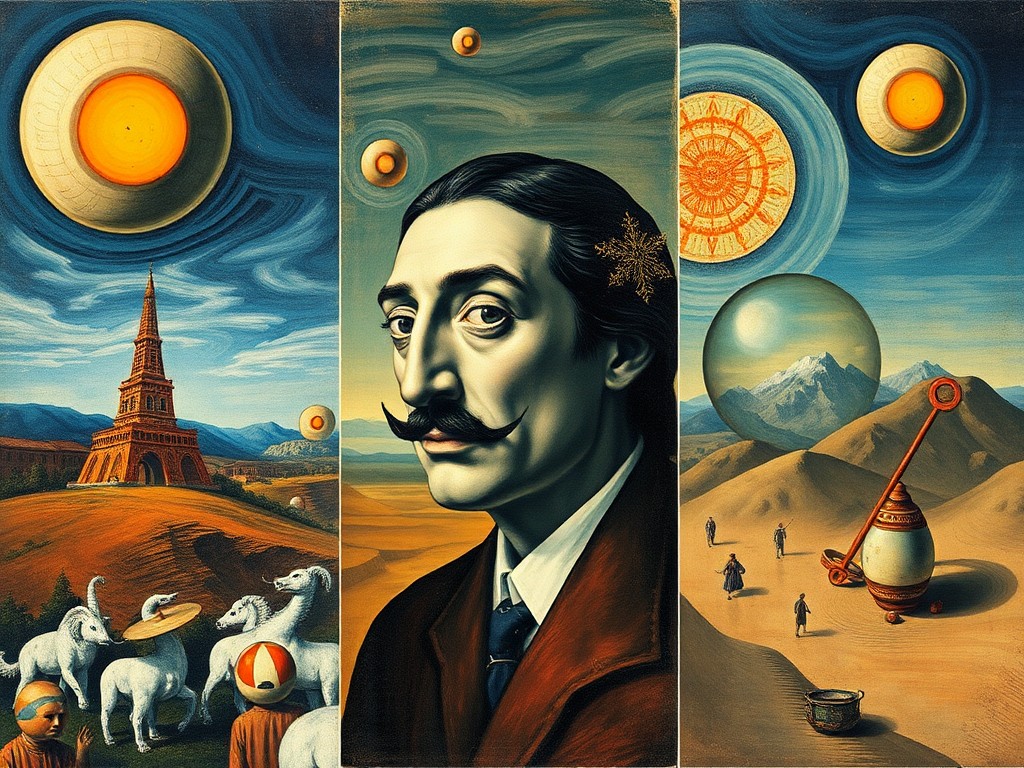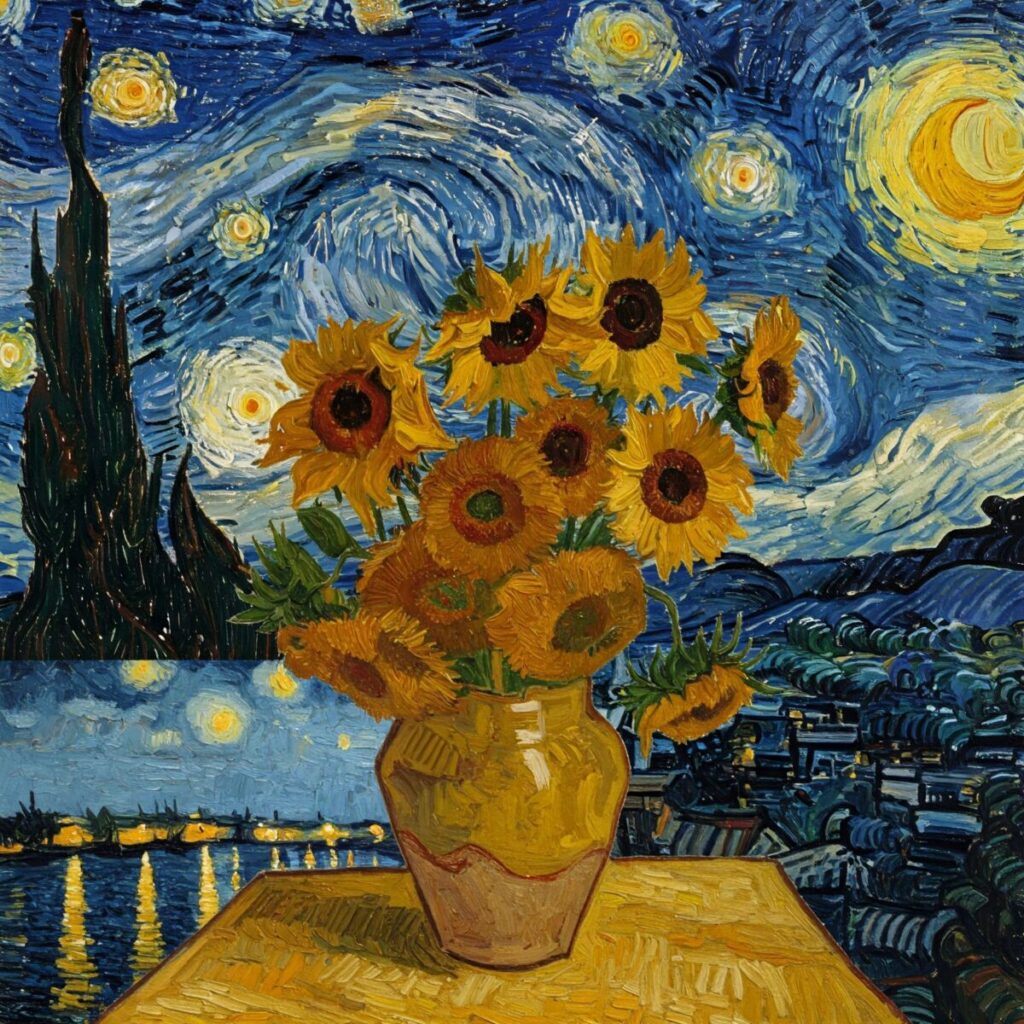Step back in time to the Victorian era, a world of dramatic stories, intense emotions, and art that looked almost real enough to touch. This was the world of Sir John Everett Millais, a rockstar artist and a founder of the Pre-Raphaelite Brotherhood. Imagine a group of young artists who thought art had become boring and wanted to bring back the detail and bright colors of Italian painting from before the famous artist Raphael. That was Millais’s mission. Exploring the most famous John Everett Millais paintings is like opening a history book filled with breathtakingly beautiful illustrations. From tragic heroines floating in rivers to scenes packed with hidden symbols, Millais’s work changed the game in British art. Get ready to discover the stories, secrets, and stunning details behind the top 10 John Everett Millais paintings.
Ophelia (1851–52)
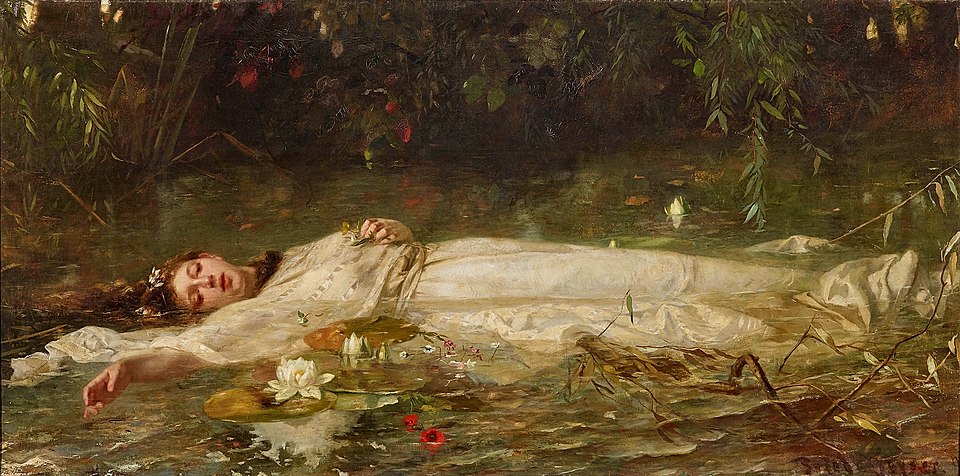
Description: This is arguably Millais’s most famous work, showing the tragic character Ophelia from Shakespeare’s ‘Hamlet’ just before she drowns. Surrounded by a stunningly detailed array of flowers and plants, she floats with a serene yet haunting expression. Millais was obsessed with accuracy, painting the background outdoors by a river in Surrey and then painting the model, Elizabeth Siddal, in a bathtub full of water back in his studio. To keep the water in the bathtub warm for his model, Millais placed oil lamps underneath it, but when they went out, she caught a severe cold and her father threatened to sue him.
Painting Techniques: Millais used the Pre-Raphaelite technique of painting on a wet, white ground to achieve luminous, jewel-like colors. Every single leaf, petal, and ripple in the water is painted with photographic precision, a style known as ‘truth to nature’.
Location: Tate Britain, London
Estimated Value: Priceless
Christ in the House of His Parents (The Carpenter’s Shop) (1849–50)
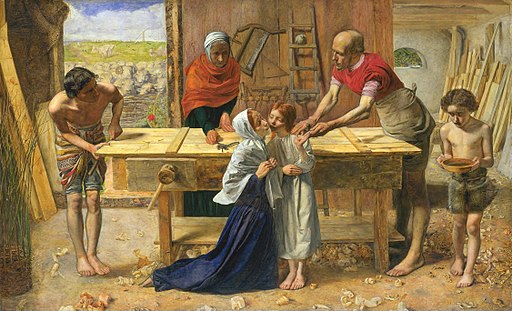
Description: This painting was incredibly controversial when it was first shown. Instead of a divine, glowing Holy Family, Millais depicted them as ordinary, working-class people in a messy carpenter’s workshop. The young Jesus has injured his hand on a nail, a foreshadowing of the crucifixion, as his mother Mary comforts him. Every detail, from the wood shavings on the floor to the tools on the wall, is rendered with intense realism. The famous author Charles Dickens was so offended by the painting’s realism that he described the figure of Mary as a ‘horrible, wry-necked, blubbering, red-headed boy… and a scarecrow’.
Painting Techniques: The painting showcases the Pre-Raphaelite commitment to realism and complex symbolism. Millais used real people as models, not idealized figures, and painted directly from observation to capture every gritty detail of the workshop.
Location: Tate Britain, London
Estimated Value: Priceless
Isabella (1848–49)
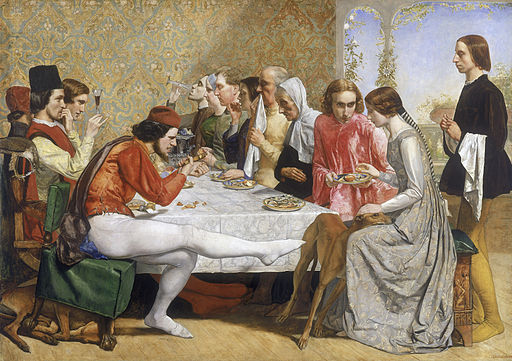
Description: Based on a poem by John Keats, this painting tells a grim story of doomed love. Isabella is in love with Lorenzo, a servant, but her cruel brothers, who want her to marry a rich nobleman, plan to murder him. Millais captures the tension at the dinner table, with one brother angrily kicking a dog while offering Isabella a blood orange, symbolizing the violence to come. The whole scene is filled with hidden clues about the tragic tale. The man who modeled for Lorenzo, William Michael Rossetti, had to balance on a pile of books for hours to get the right pose for his leg reaching towards Isabella.
Painting Techniques: This was one of the first paintings to fully embrace the Pre-Raphaelite style. Millais flattened the perspective and used sharp outlines and vibrant colors, inspired by early Italian Renaissance art. He even signed it with ‘PRB’ for Pre-Raphaelite Brotherhood.
Location: Walker Art Gallery, Liverpool
Estimated Value: Priceless
The Blind Girl (1856)
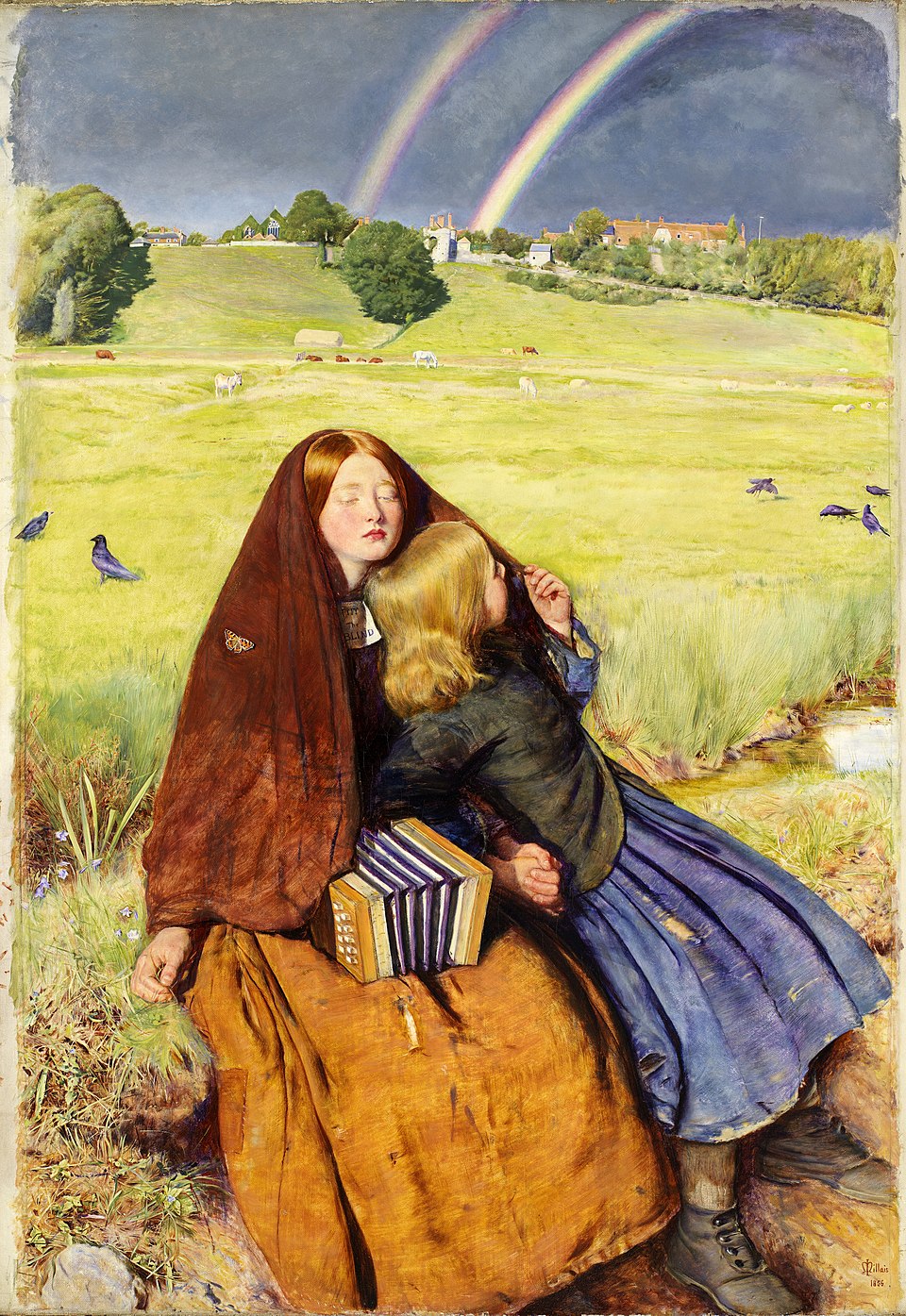
Description: This is a deeply emotional painting showing two young beggars resting by the roadside after a storm. The older girl, who is blind, feels the warmth of the sun on her face, while the younger girl looks in awe at a stunning double rainbow in the sky. It’s a painting about the senses—what one girl can see, the other can feel and hear, like the butterfly on her shawl. Millais painted this scene near Winchelsea in Sussex, and the town in the background is a real place, adding to the painting’s incredible realism.
Painting Techniques: Millais masterfully captures the effect of sunlight after rain. The colors are incredibly rich and the landscape is painted with botanical accuracy, showcasing his ‘truth to nature’ philosophy. The contrast between the dark, stormy clouds and the bright rainbow creates a powerful mood.
Location: Birmingham Museum and Art Gallery, Birmingham
Estimated Value: Priceless
Mariana (1851)
Description: Another painting inspired by poetry, this time from Alfred, Lord Tennyson’s ‘Mariana’. It shows a woman in a rich blue dress, weary from waiting for her lover who never comes. She stretches her back after hours of embroidery, her longing and frustration clear in her pose. The autumn leaves outside and the stained-glass windows add to the feeling of melancholy and confinement. The stained-glass windows in the painting depict the Annunciation, the moment the angel Gabriel tells Mary she will have a child, creating a stark contrast with Mariana’s lonely, childless waiting.
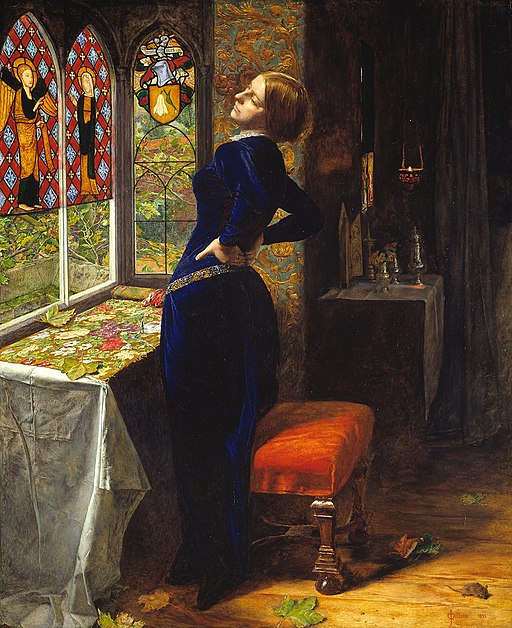
Painting Techniques: The intense, velvety blue of the dress is a triumph of color. Millais used his signature detailed style, painting every thread in the tapestry and every leaf on the ground with painstaking care. The rich colors and textures make the scene feel incredibly vivid and real.
Location: Tate Britain, London
Estimated Value: Priceless
The Order of Release, 1746 (1852–53)

Description: This painting was a huge hit with the public. It shows the wife of a defeated Scottish soldier from the Jacobite Rising who has walked barefoot to secure his release from prison. She hands the order to the jailer while her husband collapses into her arms, overcome with emotion. Their loyal dog joyfully licks his hand. It’s a powerful story of loyalty, love, and resilience. The model for the wife was Effie Gray, who was unhappily married to the art critic John Ruskin at the time; she later divorced Ruskin and married Millais.
Painting Techniques: By this point, Millais began to move towards a slightly looser, more dramatic style than his earlier Pre-Raphaelite work. He focused on capturing the raw human emotion of the scene, using dramatic lighting and powerful composition to tell the story.
Location: Tate Britain, London
Estimated Value: Priceless
Autumn Leaves (1856)
Description: This isn’t a story painting but a ‘mood’ painting. It shows four young girls in the twilight, piling up autumn leaves for a bonfire. There’s no big drama, just a quiet, thoughtful moment. The painting is meant to make you think about the beauty of nature, the passing of time, and the transition from childhood to adulthood. The wisps of smoke and the glowing sunset create a powerful sense of nostalgia and melancholy. Millais wanted to capture ‘the fragrance of the burning leaves’ in his painting, aiming to evoke senses beyond just sight.
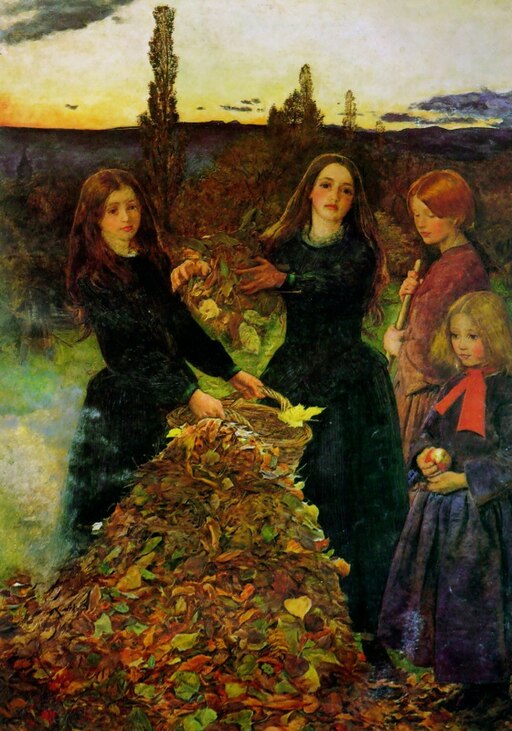
Painting Techniques: Millais focused on creating an atmosphere through color and light. The rich, earthy tones of the leaves and the deep purples of the twilight sky are stunning. He was more interested in capturing a feeling than telling a specific story, a move towards the Aesthetic Movement.
Location: Manchester Art Gallery, Manchester
Estimated Value: Priceless
The Boyhood of Raleigh (1870)
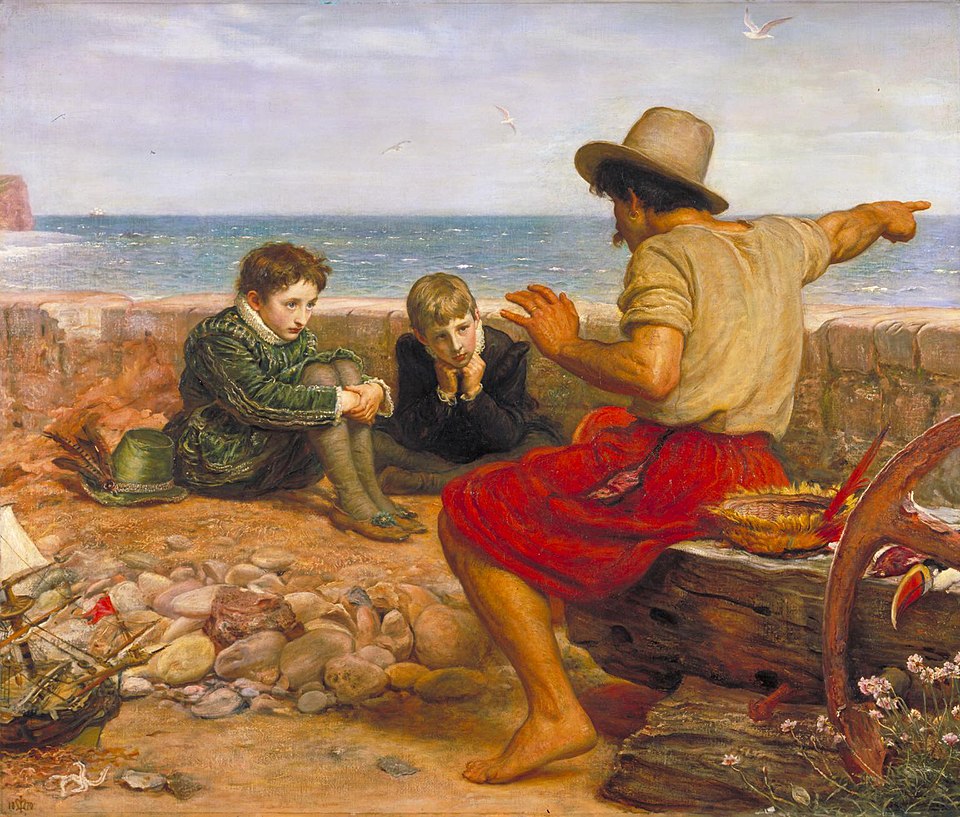
Description: This painting shows a young Sir Walter Raleigh and his brother listening intently to a sailor’s tales of adventure on the high seas. The sailor, pointing out towards the ocean, fills the boys’ heads with dreams of exploration and discovery. It’s a celebration of imagination, adventure, and the British Empire’s naval power, which made it very popular with the Victorian public. The two boys who modeled for the painting were actually Millais’s own sons, Everett and George.
Painting Techniques: This work represents Millais’s later style, which was much broader and more painterly than his early Pre-Raphaelite work. The focus is less on microscopic detail and more on creating a grand, heroic narrative with strong, clear storytelling.
Location: Tate Britain, London
Estimated Value: Priceless
A Huguenot, on St. Bartholomew’s Day (1851–52)

Description: Set during a 16th-century religious massacre in France, this painting depicts a heart-wrenching moment. A Catholic woman tries to save her Protestant (Huguenot) lover by tying a white scarf around his arm, which would mark him as a Catholic. He gently refuses, choosing to stay true to his faith even if it means death. It’s a powerful story about love, faith, and sacrifice that captivated audiences. The ivy-covered wall in the background was so important to Millais’s vision of realism that he had a brick wall specially built in his garden to paint from.
Painting Techniques: The incredible detail in the brick wall and the ivy, a classic Pre-Raphaelite trait, contrasts with the intense human drama. Millais used color and light to focus the viewer’s attention on the couple’s emotional struggle, making their silent disagreement incredibly powerful.
Location: Private Collection
Estimated Value: Last sold for £1,000,000 in 1993, now worth significantly more.
Bubbles (1886)
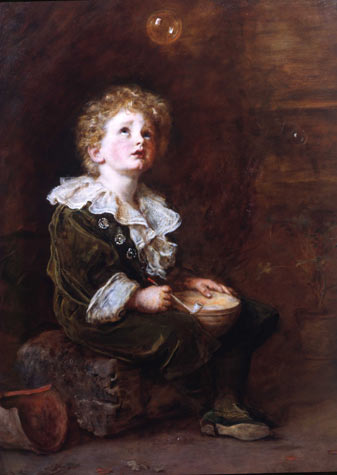
Description: Originally titled ‘A Child’s World’, this painting features Millais’s adorable grandson, Willie James, looking up in wonder at a soap bubble he has just blown. The painting captures the innocence and fleeting beauty of childhood. It became one of the most famous images of its time, but not just as a work of art. The painting was famously purchased by A. & F. Pears, the makers of Pears’ Soap, and used as an advertisement, making it one of the most recognizable pieces of commercial art in history.
Painting Techniques: This is a prime example of Millais’s late career style: sentimental, highly polished, and commercially appealing. The brushwork is smooth and the subject is designed to be charming and universally understood.
Location: Lady Lever Art Gallery, Port Sunlight
Estimated Value: Priceless
Inspiration and Legacy
John Everett Millais, along with his Pre-Raphaelite brothers Dante Gabriel Rossetti and William Holman Hunt, was initially inspired by a desire to reject the stuffy, formulaic art of the Royal Academy. They looked back to the art of the 15th-century Italian and Flemish masters—artists like Jan van Eyck and Botticelli—admiring their brilliant colors and meticulous attention to detail. Millais’s early work is a direct reflection of this ‘truth to nature’ philosophy. In turn, his legacy is immense. The intense realism and emotional depth of his Pre-Raphaelite paintings influenced the Symbolist movement across Europe. Later in his career, his more commercial and sentimental style made him one of the most successful artists of his day, and his work, particularly through popular prints, shaped Victorian popular culture in a way few other artists ever have.
Final Thoughts on Top 10 John Everett Millais Paintings
From the hyper-realistic detail of his early rebellion to the sentimental charm of his later works, the collection of John Everett Millais paintings offers a fascinating journey through the heart of Victorian Britain. He was a master storyteller, able to capture complex emotions, dramatic moments, and quiet beauty with equal skill. Millais wasn’t just a painter; he was a cultural phenomenon whose images have stayed with us for over a century. His legacy is a powerful reminder that art can be both technically brilliant and deeply moving, securing his place as one of the most important figures in the history of British art.
FAQs: John Everett Millais paintings
Who were the Pre-Raphaelites?
The Pre-Raphaelite Brotherhood was a secret group of young English artists formed in 1848. They believed that art had become corrupt and lazy since the time of the High Renaissance painter Raphael, so they wanted to return to the intense detail, bright colors, and serious subjects of earlier Italian art.
Why did Millais’s style change so much later in his life?
As Millais grew older, had a large family to support, and became more established, his style changed. He moved away from the painstaking, slow methods of the Pre-Raphaelites towards a faster, broader, and more commercially successful style that appealed to the public’s taste for sentimental stories and portraits.
Was John Everett Millais successful in his lifetime?
Yes, incredibly successful. After a controversial start, he became one of the wealthiest and most famous artists of the Victorian era. He was elected President of the Royal Academy shortly before his death and was made a baronet, a high honor from the Queen.
What is ‘truth to nature’?
‘Truth to nature’ was the core idea of the Pre-Raphaelites. It meant painting every detail of the natural world, from the veins on a leaf to the pebbles on the ground, with the greatest possible accuracy. They often painted outdoors to capture the true colors and light of a scene.

